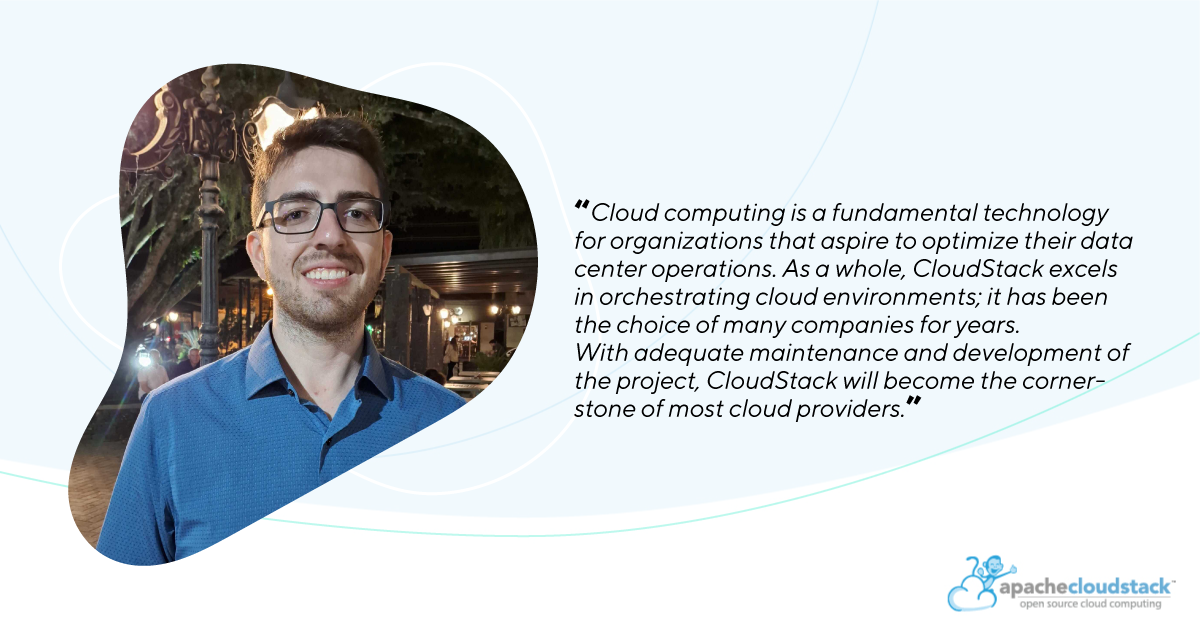
Interview: Daniel Salvador - VP of Apache CloudStack
The Apache CloudStack community is announcing that Daniel Augusto Veronezi has taken on the role of Vice President (VP) of Apache CloudStack recently, a position that bridges the gap between the vibrant community of developers and users and the Apache Software Foundation (ASF) board. In this new role, Daniel is entrusted with ensuring the health and growth of both the project and its community, guiding its further development while fostering a collaborative environment.
In our exclusive interview with Daniel, we explore the responsibilities and vision he brings to this role. As he explains, the VP’s primary duty is to serve as a liaison, ensuring effective communication and alignment between the CloudStack community and the ASF board. Despite holding this significant title, Daniel emphasizes that the VP role carries no extra privilege or weight in decision-making compared to other Project Management Committee (PMC) members. His focus will be on maintaining a healthy community and steering the project towards its future goals.
CloudStack has been a game-changer for many companies, particularly those seeking an easy-to-deploy, robust cloud management solution. With its latest enhancements, including advanced billing and white-label capabilities, CloudStack is ideal for digital service providers and companies managing large-scale virtual machine (VM) environments. Telecom companies and cloud providers, in particular, stand to benefit from CloudStack's ability to streamline VM management, enhance security, and provide detailed cost and resource tracking. Read the full interview below.
What exactly is the role of VP of Apache CloudStack?
The main role of a VP is to interface between the community/project and the ASF board. The VP is not different from the other PMC members; therefore, there is no privilege or greater weight in decisions for the person acting as VP. However, the VP is entrusted with guaranteeing the health of the community and also guiding the further development of the project and its community.
CloudStack has played a critical role for many solutions providers and companies seeking ease of use and deployment. Which companies can benefit the most from CloudStack?
The latest billing and white-label capabilities make Apache CloudStack an ideal choice for cloud and digital service providers. However, for any company that needs to manage virtual machines (VMs) to run their workloads, CloudStack can help them to better visualize costs and the workloads and ease their management while adding security mechanisms, awareness of the resources applied in each project/application, and auditing tools with respect to infrastructure changes in the VMs where they run. The most benefits of CloudStack come when one needs to support large cloud environments. Therefore, CloudStack is a reliable alternative for companies that handle several sites, like Telecoms and cloud providers.

Choosing a cloud management system is a hard thing, especially if you have a long history with specific technologies. Why should companies migrate to CloudStack?
Before choosing a technology to adopt as the basis of the cloud, the service provider needs to define its requirements, look for alternatives, and understand how it can address its needs. It all depends on the list of requirements, and the operating team that the company has. Most time, digital services companies will find out that CloudStack is the best option, with its easy-to-use graphical interface, market-ready structure, advanced features, reduced operating costs, and so on.
On the development side, how easy it is to implement and manage CloudStack?
Once you understand the CloudStack code structure, it is not hard. However, we (the community) have to understand that we have several development barriers. We are already working with a highly complex context; to work with CloudStack, developers need to understand storage, networking, virtualization, Internet protocols, and much more. On top of that, we do not use mainstream/standardized frameworks for the RESTful APIs and JPA; we use Spring in a non-standard fashion; we do not have a solid standard between our APIs, and so on. We are constantly increasing the complexity to extend/evolve and maintain ACS. That creates a bubble of development where it is hard to join, which is not healthy for a community. In fact, we already had cases of people leaving the project because of its barriers. I believe the first step toward removing those barriers is to clearly define our subjective processes, like deprecating old API methods, technologies, and development standards in favor of mainstream/standardized frameworks and technologies. For that, we have a discussion running in the community, and I invite our readers to join it: https://github.com/apache/cloudstack/discussions/8970.
What would you share about the community?
The CloudStack community is very active and is always bringing new use cases and innovation for the project. That is very interesting for the evolution of the project. We are constantly growing and developing further without being tied to a single vendor. That is in fact on of the reasons that attracts most organizations to Apache CloudStack. The diversity of its culture and community.
How do you think we can all grow the CloudStack community?
The first step towards growing the community is to admit where we are going wrong and work to fix our errors. As mentioned before, we have some development barriers; and casting light on that allows us to work on solutions. By doing that, we enable more people to contribute to the community more easily. We have to guarantee that all the contributors are being evaluated by the same criteria, not using double standards. Another thing that I and my colleagues have been considering is to host a conference in Brazil in the near future. Latin America has lots of players in the telecom and cloud-providing scenario using CloudStack as their cloud orchestrator; however, due to several factors, not all of them participate in the community or attend international conferences. Therefore, promoting even more CloudStack in Latin America can motivate them to participate and grow the community even more here, both users and contributors.
What is the direction in which Apache CloudStack is going as a technology?
Cloud computing is a fundamental technology for organizations that aspire to optimize their data center operations. As a whole, CloudStack excels in orchestrating cloud environments; it has been the choice of many companies for years. With adequate maintenance and development of the project, CloudStack will become the cornerstone of most cloud providers.
Many community members notice that CloudStack is becoming more and more appealing for enterprises. What would you advise this type of organization?
Indeed, CloudStack is becoming more appealing for large enterprise as "brick and mortar" business are getting more and more digitalized. Companies running large datacenters will find out that CloudStack is one of the best options, with its easy-to-use graphical interface, market-ready structure, advanced features, and so on. My advice to organizations adopting CloudStack is to study and understand its powerful features and develop solutions based on CloudStack's numerous functionalities.
As a person, you are recognized for your contribution to CloudStack. How did you start with it?
My CloudStack journey started in December 2020 when I started to work at SC Clouds. At first, my tasks were focused on understanding how CloudStack works and troubleshooting situations. Аfterwards, I started developing/improving features, reviewing patches, discussing solutions, and helping the community through the mailing lists. As I got more and more involved, my goals and focus changed, and now most of my efforts are on designing features and guiding/mentoring others through the community. Currently, I am mentoring more than 10 people in the community who are my colleagues in SC Clouds.
Any advice to all developers writing new features for CloudStack?
CloudStack is a complex project; therefore, before starting the development of big features, it is crucial to create a specification, so that the necessary changes are mapped, structured, and documented. We are a community with people from different places and we have different cultures, knowledge, experiences, and ways of thinking. If we do not clearly document what we are doing, it gets hard for others to maintain and evolve the features, creating a bubble of development, which is not healthy for the community. Furthermore, if one does not have a specification for the feature being developed, unnecessary code might get changed. With more code touched, more errors and bugs could be introduced. Another important point is to understand the root cause of the situations faced. It is common to see PRs intended to solve a problem by adding workarounds because the root causes of the problem are never understood; however, several times those workarounds add unnecessary complexity to the project and do not fully address the situation; they might even introduce other bugs and situations. It is very important to understand what is happening and act precisely.
If you need to summarize CloudStack in 3 words, what would they be?
I think they would be: stable, resilient, and innovative.
